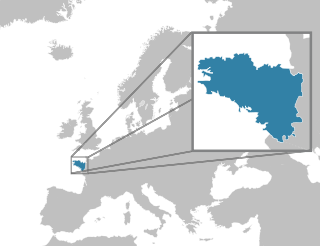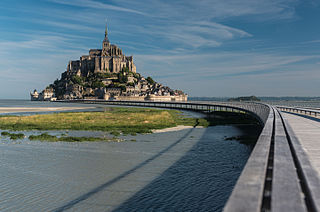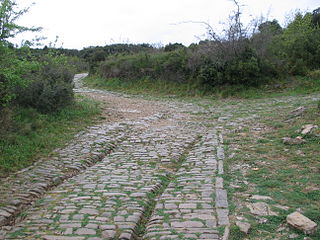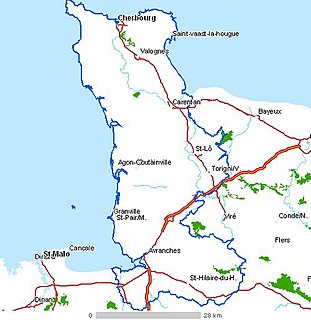
Normandy is the northwesternmost of the 18 regions of France, roughly referring to the historical Duchy of Normandy.

Brittany is a cultural region in the west of France, covering the western part of what was known as Armorica during the period of Roman occupation. It became an independent kingdom and then a duchy before being united with the Kingdom of France in 1532 as a province governed as if it were a separate nation under the crown.

Manche is a coastal French department in Normandy (Normandie), on the English Channel, which is known as La Manche, literally "the sleeve", in French.

The Via Domitia was the first Roman road built in Gaul, to link Italy and Hispania through Gallia Narbonensis, across what is now southern France. The route that the Romans regularised and paved was ancient when they set out to survey it, so old that it traces the mythic route travelled by Heracles.

Maine[mɛːn] is one of the traditional provinces of France. It corresponds to the former County of Maine, whose capital was also the city of Le Mans. The area, now divided into the departments of Sarthe and Mayenne, counts about 857,000 inhabitants.

The Cotentin Peninsula, also known as the Cherbourg Peninsula, is a peninsula in Normandy that forms part of the northwest coast of France. It extends north-westward into the English Channel, towards Great Britain. To its west lie the Channel Islands and to the southwest lies the Brittany Peninsula.

Laval is a town in western France, about 300 km (190 mi) west-southwest of Paris, and the capital of the Mayenne department. Laval was before the French Revolution part of the province of Maine, now split between two departments, Mayenne and Sarthe. Its inhabitants are called Lavallois. The commune of Laval proper, without the metropolitan area, is the 13th most populous in northwestern France and the 119th in France.

The Chouannerie was a royalist uprising or counter-revolution in 12 of the western départements of France, particularly in the provinces of Brittany and Maine, against the First Republic during the French Revolution. It played out in three phases and lasted from the spring of 1794 until 1800.

The arrondissement of Laval is an arrondissement of France in the Mayenne department in the Pays de la Loire region. It has 34 communes. Its population is 112,937 (2016), and its area is 686.1 km2 (264.9 sq mi).

The Camino de Santiago, also known as the Way of St. James, extends from different countries of Europe, and even North Africa, on its way to Santiago de Compostela and Finisterre. The local authorities try to restore many of the ancient routes, even those used in a limited period, in the interest of tourism.
Liberty Road is the commemorative way marking the route of the Allied forces from D-Day in June 1944. It starts in Sainte-Maire-du-Mont, in the Manche département in Normandy, France, travels across Northern France to Metz and then northwards to end in Bastogne, on the border of Luxembourg and Belgium. At each of the 1,146 kilometres, there is a stone marker or 'Borne'. The first lies outside the town hall in Sainte-Mère-Église.

The Train Touristique du Cotentin is a heritage railway and voluntary association in Normandy, France. The railway runs between Barneville-Carteret and Portbail on part of the former railway line linking Carentan to Barneville-Carteret in Cotentin.
The Route nationale 12, or RN12, is a trunk road (nationale) in France connecting Paris with Brittany. The road forms part of European route E50. It is approximately 570 km (350 mi) long.
The Regordane Way is the southernmost section of the historical route that links Paris to Lower Languedoc and the Camargue. It runs from Le Puy-en-Velay, south west of St Etienne to Saint-Gilles-du-Gard to the south west of Nîmes, a distance of 211 kilometres or 140 miles.

The Battle of La Brossinière or Battle of la Gravelle was a battle of the Hundred Years' War on 26 September 1423. It occurred at La Brossinière, between the forces of England and France, shortly after hostilities had resumed, following the battle of Agincourt (1415).
Narcisse Henri François Desportes was a French botanist and bibliographer who was a native of Champrond.

The Oudon is a 103.2 km (64.1 mi) long river in the Mayenne and Maine-et-Loire départements, western France. Its source is near La Gravelle. It flows generally south east. It is a right tributary of the Mayenne into which it flows between Le Lion-d'Angers and Grez-Neuville.

Jean-Loup Trassard is a French writer and photographer.
The canton of Loiron is an administrative division of the Mayenne department, northwestern France. Its borders were not modified at the French canton reorganisation which came into effect in March 2015. Its seat is in Loiron-Ruillé.

The gare de Vayrac is a French closed train station on the ligne de Souillac à Viescamp-sous-Jallès, located close to town in the Commune of Vayrac, in the département of Lot, in the region of Occitanie.